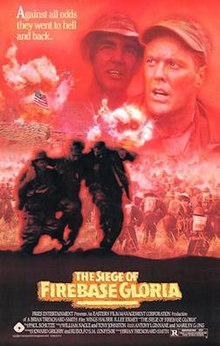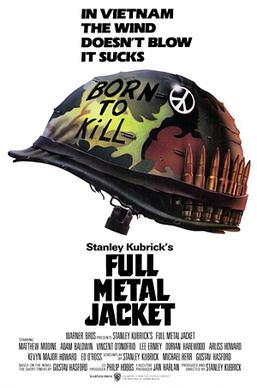
Full Metal Jacket is a 1987 war drama film directed and produced by Stanley Kubrick, who also co-wrote the screenplay with Michael Herr and Gustav Hasford. The film is based on Hasford's 1979 novel The Short-Timers and stars Matthew Modine, R. Lee Ermey, Vincent D'Onofrio and Adam Baldwin.

The Viet Cong was an armed communist organization and movement in South Vietnam, Laos and Cambodia. Formally organized as the National Liberation Front of South Vietnam, it fought under the direction of North Vietnam against the South Vietnamese and United States governments during the Vietnam War. The organization had both guerrilla and regular army units, as well as a network of cadres who organized and mobilized peasants in the territory the Viet Cong controlled. During the war, communist fighters and some anti-war activists claimed that the Viet Cong was an insurgency indigenous to the South, while the U.S. and South Vietnamese governments portrayed the group as a tool of North Vietnam. According to Trần Văn Trà, the Viet Cong's top commander, and the post-war Vietnamese government's official history, the Viet Cong followed orders from Hanoi and were practically part of the People's Army of Vietnam, or North Vietnamese army.

The Tet Offensive was a major escalation and one of the largest military campaigns of the Vietnam War. The Viet Cong (VC) and North Vietnamese People's Army of Vietnam (PAVN) launched a sneak attack on January 30, 1968, against the forces of the South Vietnamese Army of the Republic of Vietnam (ARVN), the United States Armed Forces and their allies. It was a campaign of surprise attacks against military and civilian command and control centers throughout South Vietnam. The name is the truncated version of the Lunar New Year festival name in Vietnamese, Tết Nguyên Đán, with the offense chosen during a holiday period as most ARVN personnel were on leave. The purpose of the wide-scale offensive by the Hanoi Politburo was to trigger political instability, in a belief that mass armed assault on urban centers would trigger defections and rebellions.

The Battle of Khe Sanh was conducted in the Khe Sanh area of northwestern Quảng Trị Province, Republic of Vietnam, during the Vietnam War. The main US forces defending Khe Sanh Combat Base (KSCB) were two regiments of the United States Marine Corps supported by elements from the United States Army and the United States Air Force (USAF), as well as a small number of Army of the Republic of Vietnam (ARVN) troops. These were pitted against two to three divisional-size elements of the North Vietnamese People's Army of Vietnam (PAVN).

Nguyễn Văn Lém, often referred to as Bảy Lốp, was an officer of the Viet Cong with the rank of captain. He was summarily executed in Saigon by Republic of Vietnam General Nguyễn Ngọc Loan during the Tet Offensive in the Vietnam War. A photo of the execution won the 1969 Pulitzer Prize for Spot News Photography and helped galvanize the anti-war movement in the United States.
Gerald Dwight "Wings" Hauser is an American actor and occasional director. He received an Independent Spirit Award nomination for his supporting role in Tough Guys Don't Dance (1987).
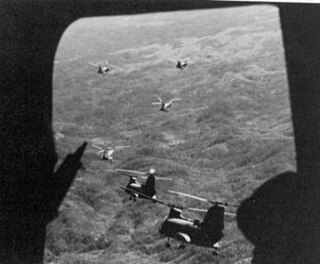
Operation Dewey Canyon was the last major offensive by the 3rd Marine Division during the Vietnam War. It took place from 22 January through 18 March 1969 and involved a sweep of the People's Army of Vietnam (PAVN)–dominated A Shau and Song Đa Krông Valleys by the 9th Marine Regiment. Based on intelligence and captured documents, the PAVN unit in contact was believed to be the 9th Regiment.

Brian Medwin Trenchard-Smith is an English-Australian filmmaker and author, known for his idiosyncratic and satirical low-budget genre films. His filmography covers action, science fiction, martial arts, dystopian fiction, comedy, war, family, thriller, romance and erotica, and his works tend to be cross-genre pieces.

The First Battle of Saigon, fought during the Tet Offensive of the Vietnam War, was the coordinated attack by communist forces, including both the North Vietnamese Army and the Viet Cong (VC), against Saigon, the capital of South Vietnam.

The First Battle of Loc Ninh was a battle during the Vietnam War that occurred between 29 October and 7 November 1967, fought by the Viet Cong, Army of the Republic of Vietnam (ARVN), Civilian Irregular Defense Group and the United States Army.
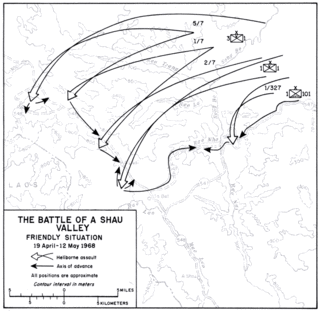
Operation Delaware/Operation Lam Son 216 was a joint military operation launched during the Vietnam War. It began on 19 April 1968, with troops from the United States and the Army of the Republic of Vietnam (ARVN) moving into the A Sầu Valley. The A Sầu Valley was a vital corridor for moving military supplies coming from the Ho Chi Minh Trail and was used by the People's Army of Vietnam (PAVN) as a staging area for numerous attacks in northern I Corps. Other than small, special operations reconnaissance patrols, American and South Vietnamese forces had not been present in the region since the Battle of A Shau in March 1966, when a U.S. Special Forces camp located there was overrun.

The 1st Division of the Army of the Republic of Vietnam (ARVN)—the army of the nation state of South Vietnam that existed from 1955 to 1975—was part of the I Corps that oversaw the northernmost region of South Vietnam, the centre of Vietnam.
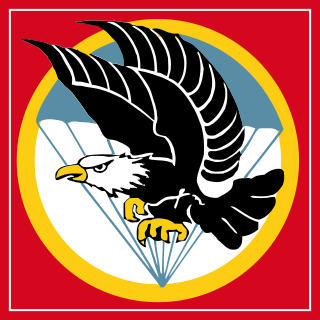
The Vietnamese Airborne Division was one of the earliest components of the Republic of Vietnam Military Forces. The Vietnamese Airborne Division began as companies organized in 1948, prior to any agreement over armed forces in Vietnam. After the partition of Vietnam, it became a part of the Army of the Republic of Vietnam. This division had its distinct origins in French-trained paratrooper battalions, with predecessor battalions participating in major battles including Dien Bien Phu and retained distinct uniforms and regalia. With the formation of an independent republic, the colonial paratroopers were dissolved, however regalia and aesthetics alongside the nickname "Bawouans" would be retained.
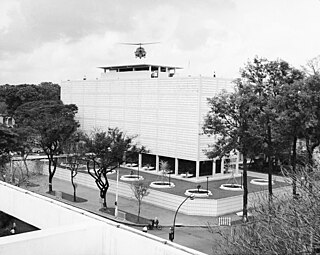
The United States Embassy in Saigon was first established in June 1952, and moved into a new building in 1967 and eventually closed in 1975. The embassy was the scene of a number of significant events of the Vietnam War, most notably the Viet Cong attack during the Tet Offensive which helped turn American public opinion against the war, and the helicopter evacuation during the Fall of Saigon after which the embassy closed permanently.

Operation Taylor Common was a search and destroy operation conducted by Task Force Yankee, a task force of the 1st Marine Division supported by the Army of the Republic of Vietnam (ARVN), southwest of Hội An from 6 December 1968 to 8 March 1969.

Vietnam in HD is a 6-part American documentary television miniseries that originally aired from November 8 to November 11, 2011 on the History Channel. From the same producers as WWII in HD, the program focuses on the firsthand experiences of thirteen Americans during the Vietnam War. The thirteen Americans retell their stories in Vietnam paired with found footage from the battlefield.
Operation Amarillo was an operation conducted by 1st Brigade, 1st Infantry Division in Bình Dương Province, lasting from 23–31 August 1966.

Operation Kunia was an operation conducted by the 1st Brigade, 25th Infantry Division in the Ho Bo Woods, lasting from 15 September to 10 November 1967.
Phase III of the Tet offensive of 1968 was launched by the People's Army of Vietnam (PAVN) and Viet Cong (VC) from 17 August to 27 September 1968. The offensive was divided into two waves of attacks from 17 to 31 August 1968 and from 11 to 27 September of that same year.

The Tet offensive attack on the US Embassy took place on the early morning of 31 January 1968 when a 19-man Vietcong (VC) sapper team attempted to seize the US Embassy in Saigon at the start of the VC's Tet offensive. While the VC successfully penetrated the embassy compound, they were unable to enter the chancery building and were pinned down by security forces, with the lone survivor eventually surrendering to US forces. Notwithstanding the attack's failure it had a profound political and psychological impact in the United States.
